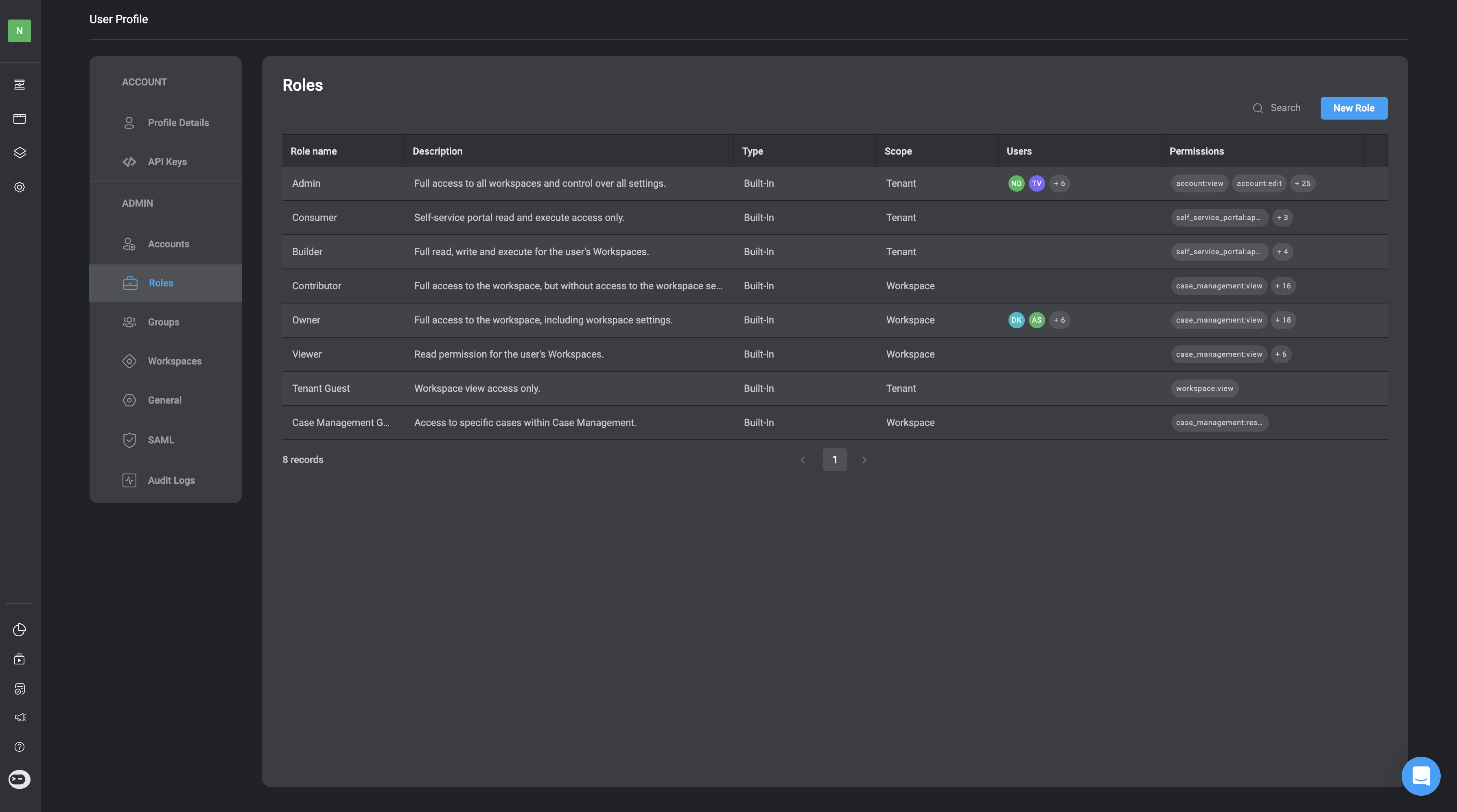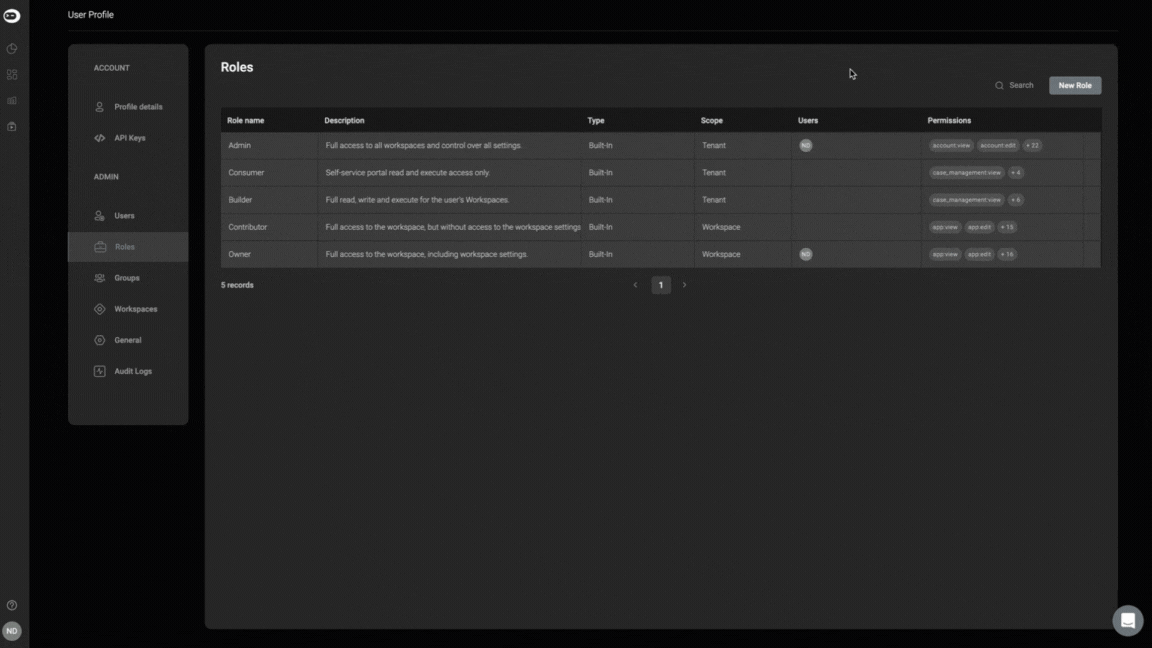
Important Key Terms to Understand: RBAC, Scopes and User Roles
- Role-Based Access Controls (RBAC) is a system that limits network access based on an individual’s role within an organization. It involves assigning permissions and privileges to ensure users have the appropriate level of access according to their roles and responsibilities.
- Scopes- A scope defines where specific tasks a user or service account in an organization can be preformed.
- User Roles are aggregations of scopes that define what tasks a user can perform based on the access permissions assigned to their role within the organization.
Tenant Role Scope
Under the Tenant Role Scope , you can be assigned a built-in user role as an Admin, Builder, Consumer, Tenant Guest or any custom user role created in your Tenant scope.1. Admin
As an Admin, you have full access to all Workspaces and control over all tenant settings. Please note that users assigned an Admin Role in the Tenant Scope have editing permissions across all tenant workspaces.
Admin Role Permissions Table
Admin Role Permissions Table
| Feature | Description | Permissions |
|---|---|---|
| Account Settings | View entities and settings. | account:view |
| Account Settings | Invite users to the account. | account:invite |
| Account Settings | Create entities and update all settings. | account:edit |
| Self-Service Portal | View Services | self_service_portal:service:view |
| Self-Service Portal | View Apps | self_service_portal:app:view |
| Self-Service Portal | Execute Services | self_service_portal:service:execute |
| Self-Service Portal | Execute Apps | self_service_portal:app:execute |
| Workspaces | View Personal Workspace | workspace:view:personal |
| Workspaces | View Workspaces | workspace:view |
| Workspaces | Create Workspaces | workspace:create |
2. Consumer
As a Consumer, you have full access to Self-service portal access and read only access to Case managementConsumer Role Permissions Table
Consumer Role Permissions Table
| Feature | Description | Permissions |
|---|---|---|
| Self-Service Portal | View Services | self_service_portal:service:view |
| Self-Service Portal | View Apps | self_service_portal:app:view |
| Self-Service Portal | Execute Services | self_service_portal:service:execute |
| Self-Service Portal | Execute Apps | self_service_portal:app:execute |
3. Builder
As a Builder, you have access to workspaces you are a member of and have full access to the Self Service Portal.Builder Role Permissions Table
Builder Role Permissions Table
| Permissions | Description | Feature |
|---|---|---|
| Self-Service Portal | View Services | self_service_portal:service:view |
| Self-Service Portal | View Apps | self_service_portal:app:view |
| Self-Service Portal | Execute Services | self_service_portal:service:execute |
| Self-Service Portal | Execute Apps | self_service_portal:app:execute |
| Workspaces | View Personal Workspace | workspace:view:personal |
| Workspaces | View Workspaces | workspace:view |
| Workspaces | Create Workspaces | workspace:create |
4. Tenant Guest
As a Tenant Guest you have only access permissions to view WorkspacesTenant Guest Permissions Table
Tenant Guest Permissions Table
| Permissions | Description | Scope |
|---|---|---|
| Workspaces | View Workspaces | workspace:view |
Workspaces Role Scope
Under the Workspace Role Scope , you can be assigned a built-in role as an Owner, Contributor, Viewer or Case Management Guest or any custom Workspace user role created in your Tenant. To assign a user a Workspace Role , follow these instructions.1. Owner
As an owner, you have full access to the workspace and workspace settings.Owner Role Permissions Table
Owner Role Permissions Table
| Feature | Description | Permissions |
|---|---|---|
| Case Management | View existing cases | case_management:view |
| Case Management | Create and edit cases. | case_management:edit |
| Case Management | Close cases. | case_management:close_case |
| Case Management | Delete Cases. | case_management:delete_case |
| Case Management | Manage case management settings. | case_management:admin |
| Connections | View existing connections | connections:view |
| Connections | Create and edit connections | connections:edit |
| Global Variables | View existing global variables | global_variables:view |
| Global Variables | Create and edit global variables | global_variables:edit |
| Runners | View existing runners | runners:view |
| Runners | Create and edit runners | runners:edit |
| Tables | View existing tables | tables:view |
| Tables | Create and edit tables | tables:edit |
| Workflows | View existing workflows | Workflow:view |
| Workflows | Publish Workflows | workflow:publish |
| Workflows | Create and edit workflows | workflow:edit |
| Workflows | Execute workflows | workflow:execute |
| Workflows | Approve Workflows | workflow:approve |
| Workspaces | Share workspaces resources | workspaces:share |
| Workspaces | Update workspace settings | workspaces:edit |
| Workspaces | Delete workspaces | workspaces:delete |
2. Contributor
As a contributor, you have full access to the workspaces.Contributor Role Permissions Table
Contributor Role Permissions Table
| Feature | Description | Permissions |
|---|---|---|
| Case Management | View existing cases | case_management:view |
| Case Management | Create and edit cases. | case_management:edit |
| Case Management | Close cases. | case_management:close_case |
| Case Management | Delete Cases. | case_management:delete_case |
| Case Management | Manage case management settings. | case_management:admin |
| Connections | View existing connections | connections:view |
| Connections | Create and edit connections | connections:edit |
| Global Variables | View existing global variables | global_variables:view |
| Global Variables | Create and edit global variables | global_variables:edit |
| Runners | View existing runners | runners:view |
| Runners | Create and edit runners | runners:edit |
| Tables | View existing tables | tables:view |
| Tables | Create and edit tables | tables:edit |
| Workflows | View existing workflows | Workflow:view |
| Workflows | Publish Workflows | workflow:publish |
| Workflows | Create and edit workflows | workflow:edit |
| Workflows | Execute workflows | workflow:execute |
| Workflows | Approve Workflows | workflow:approve |
| Workspaces | Share workspace resources | workspaces:share |
3. Viewer
As a viewer, you can only observe the mentioned features without the ability to edit or create them.Viewer Role Permissions Table
Viewer Role Permissions Table
| Feature | Description | Permissions |
|---|---|---|
| Case Management | View existing cases | case_management:view |
| Connections | View existing connections | connections:view |
| Global Variables | View existing global variables | global_variables:view |
| Runners | View existing runners | runners:view |
| Tables | View existing tables | tables:view |
| Workflows | View existing workflows | workflow:view |
4. Case Management Guest
As a Case Management Guest, you have access permissions to specific cases within Case Management.Case Management Guest Role Permissions Table
Case Management Guest Role Permissions Table
| Feature | Description | Scope |
|---|---|---|
| Case Management | Edit only the cases shared with the user and their groups, including any linked entities | case_management:restricted |
Adding a New Custom Role
- In the top-right corner, click on New Role button in the top right-corner.
- A dialogue box will open, displaying all user role permissions.
- Add a Role Name and a Role Description.
- Select a Role Scope by selecting between a Tenant Role or a Workspace Role from the dynamic dropdown.
Please note that Tenant Role or a Workspace Role have different access permissions
Tenant Scope Permissions
Tenant Scope Permissions
| Feature | Permission | Description |
|---|---|---|
| Account settings | account:view | View entities and settings |
account:invite | Invite users to the account | |
account:edit | Create entities and update all settings | |
| Self-Service Portal | self_service_portal:app:view | View apps |
self_service_portal:service:view | View services | |
self_service_portal:app:execute | Execute apps | |
self_service_portal:service:execute | Execute services | |
| Workspaces | workspace:view | View user’s associated workspaces |
workspace:view:personal | Access user’s personal workspace | |
workspace:create | Create workspaces |
Workspace Scope Permissions
Workspace Scope Permissions
| Feature | Permission | Description |
|---|---|---|
| Case Management | case_management:restricted | View and edit only the cases shared with the user and their groups, including any linked entities |
case_management:view | View existing cases | |
case_management:edit | Create and edit cases | |
case_management:close_case | Close cases | |
case_management:delete | Delete case management entities | |
case_management:admin | Manage case management settings, including editing a case, closing a case, and deleting a case | |
| Connections | connection:view | View existing connections |
connection:edit | Create and edit connections | |
| Dashboards | dashboard:view | View existing dashboards |
dashboard:edit | Create and edit dashboards | |
| Global Variables | global_variable:view | View existing global variables |
global_variable:edit | Create and edit global variables | |
| Runners | runner:view | View existing runners |
runner:edit | Create and edit runners | |
| Tables | table:view | View existing tables |
table:edit | Create and edit tables | |
| Workflows | workflow:view | View existing workflows |
workflow:execute | Execute workflows | |
workflow:edit | Create and edit workflows | |
workflow:publish | Publish workflows | |
workflow:approve | Review and approve workflow changes | |
workspace:share | Share workspace resources | |
workspace:edit | Update workspace settings | |
workspace:delete | Delete workspace |
- Then, select the relevant checkboxes to customize user role permissions and then click the create icon.
